
Galls or cecidia are a kind of swelling growth on the external tissues of plants, fungi, or animals. Plant galls are abnormal outgrowths of plant tissues, similar to benign tumors or warts in animals. They can be caused by various parasites, from viruses, fungi and bacteria, to other plants, insects and mites. Plant galls are often highly organized structures so that the cause of the gall can often be determined without the actual agent being identified. This applies particularly to some insect and mite plant galls. The study of plant galls is known as cecidology.
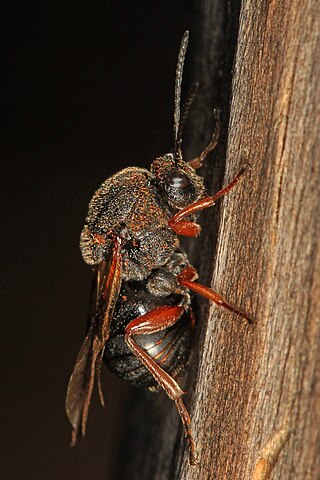
Gall wasps, also traditionally calledgallflies, are hymenopterans of the family Cynipidae in the wasp superfamily Cynipoidea. Their common name comes from the galls they induce on plants for larval development. About 1,300 species of this generally very small creature are known worldwide, with about 360 species of 36 different genera in Europe and some 800 species in North America.

Oak apple or oak gall is the common name for a large, round, vaguely apple-like gall commonly found on many species of oak. Oak apples range in size from 2 to 4 centimetres in diameter and are caused by chemicals injected by the larva of certain kinds of gall wasp in the family Cynipidae.
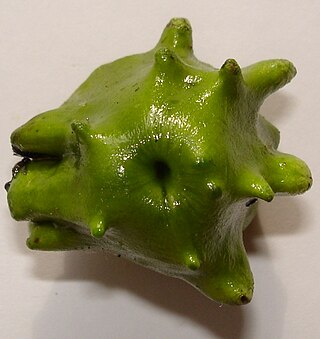
Andricus quercuscalicis is a gall wasp species inducing knopper galls.

Andricus kollari, also known as the marble gall wasp, is a parthenogenetic species of wasp which causes the formation of marble galls on oak trees. Synonyms for the species include Cynips kollari, Andricus quercusgemmae, A. minor, A. indigenus and A. circulans.

Andricus foecundatrix is a parthenogenetic gall wasp which lays a single egg within a leaf bud, using its ovipositor, to produce a gall known as an oak artichoke gall, oak hop gall, larch-cone gall or hop strobile The gall develops as a chemically induced distortion of leaf axillary or terminal buds on pedunculate oak or sessile oak trees. The larva lives inside a smaller hard casing inside the artichoke and this is released in autumn. The asexual wasp emerges in spring and lays her eggs in the oak catkins. These develop into small oval galls which produce the sexual generation of wasps. A yew artichoke gall caused by the fly Taxomyia taxi also exists, but is unrelated to the oak-borne species. Previous names or synonyms for the species A. fecundator are A. fecundatrix, A. pilosus, A. foecundatrix, A. gemmarum, A. gemmae, A. gemmaequercus, A. gemmaecinaraeformis and A. quercusgemmae.
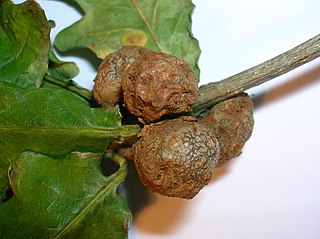
Cola-nut galls develop as a chemically induced distortion of leaf axillary or terminal buds on pedunculate oak or sessile oak trees, caused by the agamic gall wasp Andricus lignicola which lays single eggs within leaf buds using their ovipositor. A previous name or synonym for the species A. lignicola is A. lignicolus and A. venheurni.
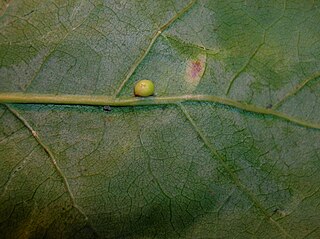
Neuroterus anthracinus is a widely distributed gall wasp that forms chemically induced leaf galls on oak trees. N. anthracinus has both sexual and agamic generations and in consequence forms two distinct galls, the oyster gall and April-bud gall.

Biorhiza pallida is a gall wasp species in the family Cynipidae. This species is a member of the tribe Cynipini: the oak gall wasp tribe. Cynipini is the tribe partially responsible for the formation of galls known as oak apples on oak trees. These are formed after the wasp lays eggs inside the leaf buds and the plant tissues swell as the larvae of the gall wasp develop inside. This wasp has a widespread distribution within Europe.

Biorhiza is a genus of gall wasps in the family Cynipidae in the tribe Cynipini: the oak gall wasp tribe. Cynipini is the tribe partially responsible for the formation of galls known as oak apples on oak trees. These are formed after the wasp lays eggs inside the leaf buds and the plant tissues swell as the larvae of the gall wasp develop inside.

Cynipini is a tribe of gall wasps. These insects induce galls in plants of the beech and oak family, Fagaceae. They are known commonly as the oak gall wasps. It is the largest cynipid tribe, with about 936 to 1000 recognized species, most of which are associated with oaks. The tribe is mainly native to the Holarctic. Cynipini wasps can act as ecosystem engineers. Their galls can become hosts of inquilines, and the wasps themselves are hosts to parasitoids.
Bassettia is a genus of gall wasps found in North America.

Andricus curvator is a gall wasp which forms chemically induced leaf galls on oak trees and has both agamic and sexual generations. Agamic and sexual generations usually form two distinct galls on oak trees, but in the case of A. curvator there are six galls; the sexual generation usually on the leaf, occasionally in a twig or catkin, and the agamic generation in a bud. The wasp was first described by Theodor Hartig, a German biologist, in 1840 and is found in most of Europe.

Andricus inflator is a species of gall-forming wasps, in the genus Andricus, which has a sexual and an asexual generation, producing two different galls. The wasp was named by the German biologist Theodor Hartig, in 1840 and is found in Europe.

Callirhytis is a genus of gall wasps in the family Cynipidae. There are more than 90 described species in Callirhytis.
Andricus mukaigawae is a species of gall wasp native to southeastern Asia. It creates galls on the buds and leaves of oak trees. The galls are sometimes used by other gall wasps unable to create galls of their own, with both species sharing the gall.
Callirhytis seminator, the wool sower, is a species of gall wasp in the family Cynipidae.

Cynips quercusechinus, the urchin gall wasp, is a species of gall wasp in the family Cynipidae. It induces galls in the leaves and leaf buds of blue oak and scrub oak. Like other oak gall wasps, it has two generations: a bisexual generation, and a parthenogenic female generation. In spring, the hatching bisexual generation produces hollow green galls in leaf buds. In summer, the unisexual generation induces its galls, which are red or pink and resemble sea urchins, on the undersides of leaves. These galls are about 10 millimetres (0.39 in) in diameter. The galls fall with the leaves in autumn, and the larvae inside of them emerge as adults in the spring and lay their eggs.
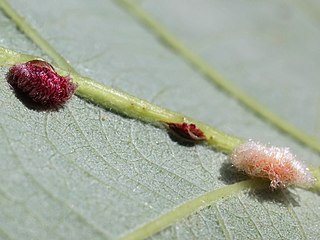
Druon ignotum is a species of gall wasp in the family Cynipidae.
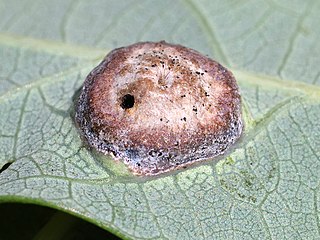
Callirhytis quercusfutilis, the oak wart gall wasp, is a species of gall wasp in the family Cynipidae.
















